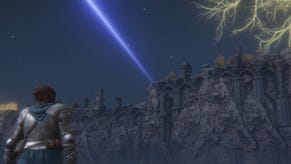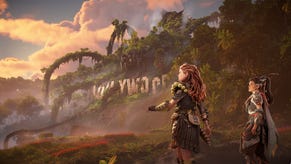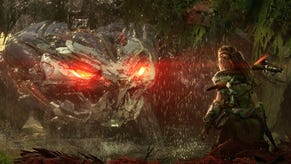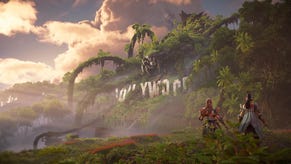Horizon Forbidden West review: Another beautiful string to Aloy's bow, despite some open world drawbacks
Aloy is set to go west – where the skies are blue – but will life be peaceful there, or will mysterious threats ruin her freshly-minted hero status?
You’ve just slid under a robotic elephant’s tusk as it tried to gore you with the entirety of its 10-tonne-plus weight. Some of your flowing red hair caught the tip of its kevlar tusk. But that hasn’t phased you; you look up, pull out an explosive spear and jam it under the beast’s jaw. A dodge roll to safety, a quick sprint behind a nearby knoll, and a look over your shoulder tells you it was a clean hit – the resulting explosion took the beast’s plated armour clean off. You notch an arrow to your bow, concentrate as you take aim, and fire. Bullseye! The tusk comes off, clean. Just what you needed for that weapon upgrade.
Does this sound familiar? Because it is. Moment-to-moment, Horizon Forbidden West isn’t all that different from Zero Dawn. Sure, there are more bells and whistles, the world is bigger (and, somehow, also more dense), you’ve got some fancy new ways of getting about, and there are some new robotic animals to dispatch. But this is Zero Dawn, Mark II. For better and for worse.
Guerrilla Games bolted out the gate with aplomb on its first venture into the reset future of the Horizon universe, kitbashing together some fluid My First Monster Hunter combat, a rich and tempting world full of collectible goodies, and a story that had the true identity of red-headed huntress Aloy nestled snugly at its center. Without that central conceit, though, Forbidden West seemed like a dubious proposition – could this 60-plus hour game keep me entertained, even when this main plot point has been removed?
Short answer; "yes" with an "if." Long answer, "no" with a "but". What Forbidden West lacks in narrative punch, it makes up for with its combat and some spectacularly-conceived set pieces. Just when you get bored with an errand making you go kill a Snapmaw again, or when you get frustrated with being sent back to an already-plundered location for a side quest when there’s a whole world to explore, the game always has another hook baited for you in a story mission to get you back onside.
But that’s not to say all the superfluous stuff is turgid; take the Tallnecks – those giraffe-cum-Brontasaurus machines from the first game that you need to climb to unveil local map markers. Forbidden West only wants you to do the standard find, climb, and scan stuff once. From then on, there’s always another way of tackling them – whether that’s using ballistas to bring them down in the midst of a Ravager siege, figuring out how to navigate a rudimentary Go Ape course to get high enough to override them, or whatever else, there’s typically a fresh take on the assumed task. A fair share of the map icons in Forbidden West map do this, too. Eat your heart out, Assassin’s Creed.
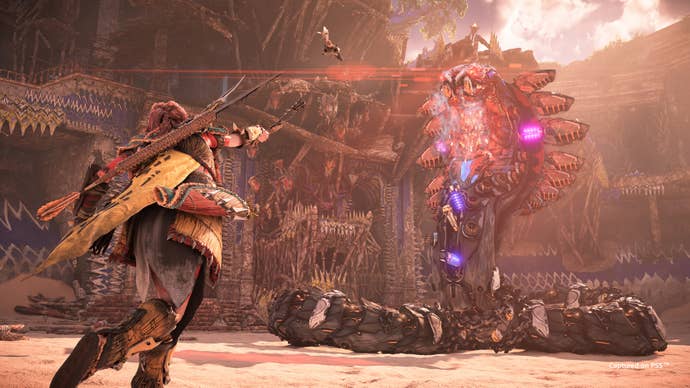
Open world fatigue is real, of course. A wealth of errands are drab, and the writing outside of the main quest (and main cast) is questionable at best, off-putting at worst. But that’s fine, because you’re only doing some of those missions to get more experience, right? The meat of this game is in working through the story, and wrapping up loose ends that fray off from the main narrative thread in the process. It’s just a shame about the go-here, do-this trudge that forms a large percent of the non-story experience.
About 10 hours in, you’ll unlock a sort-of hub – a home for Aloy where allies and friends gather. It reminds me of Mass Effect and the Normandy; you can grab what are effectively loyalty missions from the ragtag team that assembles over the course of the game. Here lies the game’s heart, really; the end of the world is fast approaching, but going off on one to find a replacement arm for your ex-warrior mate resounds a lot more than stopping some sort of synthetic plague.
Guerrilla uses this base to really throw you out into the world, too, and highlight the bits it really wants you to see (and rightly so, because the map is bloody massive). ‘Remember that place you ran through in this story mission?’ the developer asks when you ask your newly-found friend why they’re so glum. ‘Go back there, and really get to know it. We think you’ll enjoy it.’ Suddenly, my quest to halt the terraforming threat that’s about to bring the world to its knees evaporates, and I’m in a village ogling the local flora and trying to find a way to make someone I’ve known for about 25 minutes a bit less sad. Credit to you, Guerrilla, you’ve side-tracked me again, and I’m enjoying it. This time.
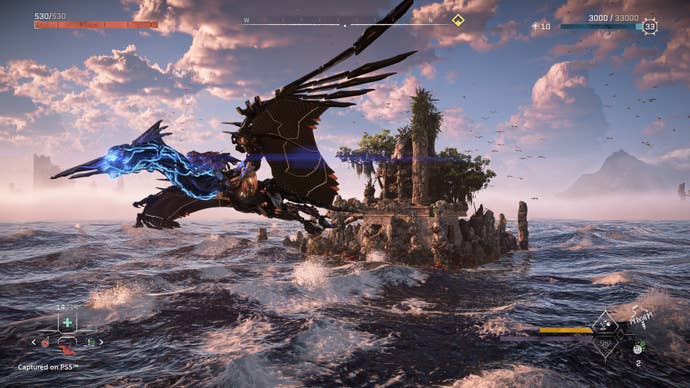
It helps that this is one of the best-looking games I’ve ever played, too. Being tossed from the top of the map to its left-most extreme is bearable if I’m going from frozen mountains to lush, West Coast beaches. ‘Hey, maybe I’ll stop off at that jungle village en route to mop up that combat pit quest,’ I think as I set out on what will no doubt be a three-hour detour. An hour of that is in Photo Mode, as I try to capture Aloy’s face as she gets clotheslined off her mount into the snow, and some electric-fanged panther thing comes diving at her.
The combat itself is pumping. The new additions – Valor Surges you can deploy like special moves that give you stat buffs, new melee options that make hand-to-hand less of a drag, new weapons to break up the rhythm – are all OK, but they’re nothing worth writing home about. This series is always going to be about the rhythm of trapping, sneaking and shooting from range – every single encounter (except a few specific story battles) give you the option of starting from stealth. And rightly so, because that’s what this game is all about.
The Decima Engine’s obsession with growing long grass everywhere gives you plenty of opportunity to get close to machines, target their weak parts, and go about dissembling them with precision bow shots, explosive javelins, boomerang discs, plasma-loaded crossbow bolts, acid bombs and whatever other deadly ephemera Aloy has managed to cram into her suspiciously concealed pouches.
When the game is firing on all cylinders (you’ve set a trap to knock an avian machine out the air, you’ve peppered with arrows on the way down, and now you’re flinging glue bombs at it with impish glee), it’s hard not to love Forbidden West. It makes you feel like a superhero. After a fight with some behemoth bat-like thing in a late-game story mission, a companion remarks “I’ve never seen anyone fight machines like you Aloy!” Damn straight. I just took its ears off from about 100 meters away! Then I set it on fire! As I shredded its wings with razors! I’m a hunter god.
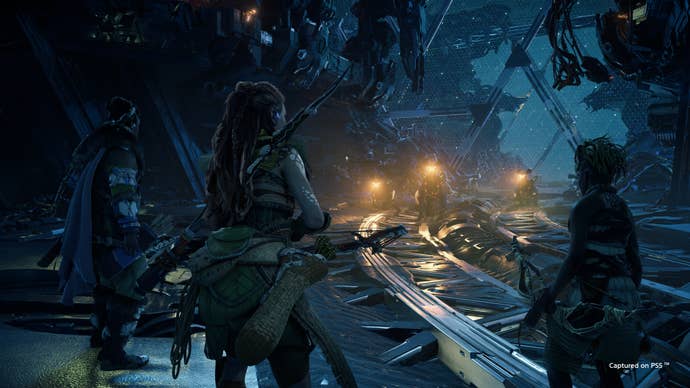
It’s a shame that the connective tissue between the set-pieces fails to burn as clean as the rest of the game. It’s thrilling to hit a new big narrative beat, see the wondrous zones that open up before you, and marvel at the technological feats Guerrilla has crammed into the game (the Las Vegas bit is going to be an all-timer, for example). But once you’ve saved the day for the locals and they start whining about a local machine that’s stolen their fuel supply, or want you to retrieve something from an outcrop in those hills, you start to roll your eyes. ‘I’m only doing this because I need the money,’ you mutter under your breath as you accept. You don’t do that in The Witcher, do you?
A novel mini-game helps plaster over some of the cracks in your downtime, and a breadth of collectibles litter the map, too, but there’s no hiding from the fact that – on the exhale – Forbidden West suffers from open world bloat. It’s satisfying to leap off a mountaintop, glide down into a new biome, absolutely obilterate some peacefully grazing machines and then grappling hook your way outta there, but rinse and repeat that across the whole map and it starts to get a bit monotonous.
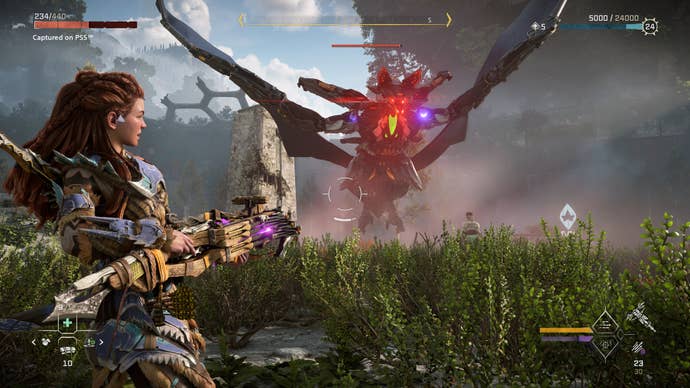
Perhaps I’m focusing a bit too much on the negatives here, but it’s what forms a lot of the process. I’ve put over 60 hours into Horizon: Forbidden West for this review, and the majority of that time has been spent in the world, helping my companions with their woes, and tending to the moronic NPCs that can’t do anything for themselves. It casts a shadow on the bombast and intrigue of the central plot – in a world where we’re seeing games weave these two elements together so satisfyingly, you can’t help but notice a title that doesn’t.
Horizon: Forbidden West does a great job of building on the foundation that Zero Dawn laid out; everything is more beautiful, the stakes are – somehow – higher, and the flirtations with BioWare-style story ideas shows just how much of a future this series has. The exploration and combat pillars of the game sing in harmony, too… it’s just a shame that there’s so much sludgy filler amongst all that well-oiled machine killer.



